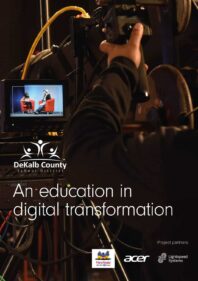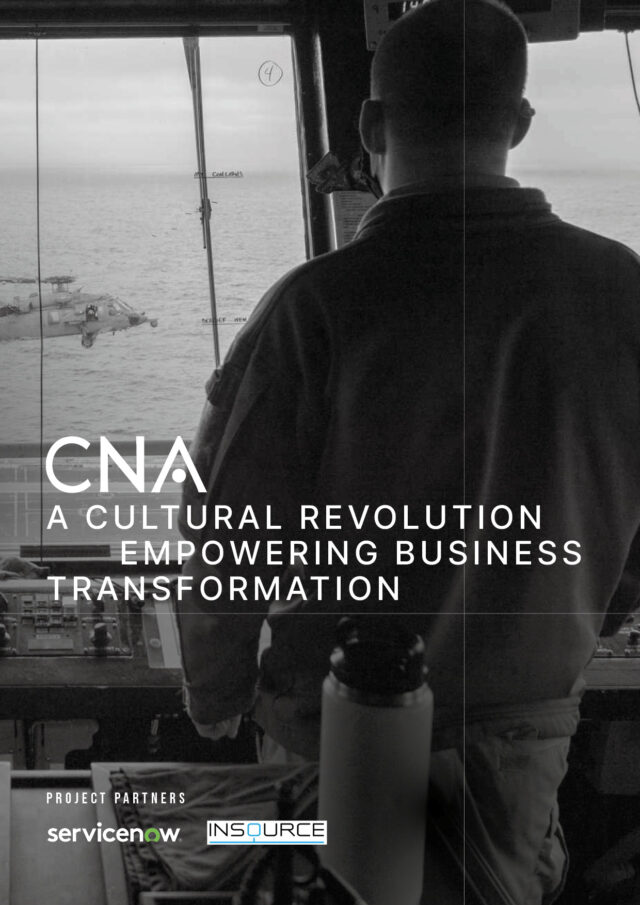Education has experienced an incredible amount of reconfiguration. Digital transformation is redefining, evolving and accelerating the educational landscape to equip schools, teachers and students with the necessary tools, platforms and knowledge befitting of 21st Century institutions and client expectations. Higher education and private schools were the first to dip their toes into innovation, primarily a result of increased competition and customer expectation; boosted by rising fees. Of course, the other major driver of digital transformation in the classroom is the need to maximize the classroom experience. Tax-funded schools and colleges are making enormous progress in improving the quality and access to modern education for all.

DeKalb County School District (DCSD) is Georgia’s third largest school system, serving just under 100,000 students, 139 schools and centers, and employing 16,242 staff. In 2016, a decision was taken to undertake a digital transformation of its schools, in a bid to boost the educational experience for every stakeholder. The digital transformation was branded Digital Dreamers, an ambitious four-year strategy funded by SPLOST, which released and invested taxpayer dollars through capital spending. The primary aim was to construct a digital ecosystem that would provide teachers and students with the necessary tools and resources to revolutionize the learning experience.
Derrick Brown is the chief information officer at DeKalb County School District in Georgia: “Four years ago they (DCSD) started the strategic thinking and branding of Digital Dreamers; the digital ecosystem hosting platforms such as Verge, ItsLearning, a learning management and instructional system containing all online tools for virtual learning. The instructional ecosystem has been designed to virtually meet the needs of educators and learners,” Brown explains.
Brown and his colleagues in Curriculum & Instruction and Student Support Services provide online curriculum and tools for math, science and the core curriculum, as suggested by the teaching staff, who work closely with his team to shape the educational landscape. “And that’s where the magic happens, in how that teacher engages with the students. Because they all learn differently. For some it’s personalized, and so sometimes we differentiate, but at the end of the day, it’s the teachers who know the appropriate tools and ways to engage with their students.”
Brown is relatively new to DCSD. He joined the district in November 2019, but this work isn’t new for him. He did similar work for another major school district. Brown is not the product of a traditional career path in education, and was bitten by the education bug while consulting in Portland Public Schools for one year then joined full time and served for another three years in various IT leadership roles. Brown facilitated a similar digital transformation to the one at Dekalb, while working for The Evergreen Public Schools in Washington. “We were going through this exercise some years ago, about the same time as DeKalb and we started with what we called the Four Cs: creativity, communication, collaboration, and critical thinking. That’s pretty much still the practice here at DeKalb.”
DeKalb’s digital learning platform Verge, (constructed by global software developer ItsLearning) has equipped all students and educators with access to Virtual Learning. Students in grades 6 through 12 to take home devices to continue learning. In elementary school students have access to shared devices in mobile carts. Virtual assignments and content can be delivered by the teacher, as well as learning materials and research aids. A couple of years ago “There was a fear from parents when devices were distributed to students from school districts throughout the nation regarding screen time and what might that look like for my child, but they’re used intentionally and with purpose for access and to enhance learning. Students don’t have their devices on their desk all day. The teacher is instructing and can still use many different tools: paper, books, or other means. And then when appropriate, instruct the students to use the devices for whatever task they might be doing.”
Brown’s team currently has approximately 175 employees with executive leadership in instructional technology supporting teachers as well as infrastructure and support services responsible for the district’s network, enterprise systems & servers, unified communications, cyber security and technical support to name a few. Verge is a complete system connected to DeKalb’s digital learning platform, built on Itsearning’s management system. That entire digital ecosystem contains grade level, teacher-created content. “So, we provide the digital tools, and then they (the teachers) take those tools to create their own lesson plans. That’s the ecosystem running right now for teachers to virtually provide for the children.”
According to Brown many public schools are expected to operate “like Fortune 100 companies” available 24 hours a day, if not physically, then virtually. “And so, leadership and essential staff are always on call. We always felt that way as a technology division within education, but now we’re at the front of the bus instead of the back, so to speak, because they’re utilizing these systems in a way they never have before, at all times of the day and night, globally. We’re not always able to afford, as a school district, the best of everything, but we want to make sure that we’re implementing enterprise equipment and solutions with fidelity and leveraging Gartner for research and calls with industry analysts about technology tools.”

Collaboration is common in many industries but is essential in public education. Brown’s background is in IT project management, more focused with human capital and managing large national technology projects, which makes sense when most of the work carried out in IT is through relationships, communication, organizational skills, managing budgets, professional development, training and leadership. “Communication and understanding the problems you’re trying to solve, and that they have a beginning and an end, and that they operationalize, are important. So that fits quite nicely into education. And one of the things I love about education is that we share. There is no competition. We’re all doing the same thing, and in the business to educate our students, and so it’s wonderful to serve and support. We pick up the phone and call our peers all over the country for guidance, insight and learn from their experiences. It’s communication through the building of relationships, conferences and networking. We, IT leaders, have to be tremendous listeners. Great listeners. And not just building the tools that we want, but making sure that it’s delivering what our teachers, families and students need.”
DeKalb is incredibly fortunate that turnover of staff is low. That allows for the continued growth of the experience within the team for succession planning and for creativity and new thinking under the leadership of new executive directors. “It gives us an opportunity to get into the buildings with our staff and begin actively seeing and listening to students, teachers and administrators. How are we meeting their needs? Because, at the end of the day, it’s making sure that we understand and are observing the behaviors in the classroom so that we can adjust and modify the tools we’re offering. For a true digital transformation in instruction, we have to know what is happening at the schoolhouse and to have that open dialogue frequently throughout the school year so that we can continue to be agile and flexible.”
Many organizations, not just education, are looking for thought leaders because of the influence of IT at the core of the business, from a data and analytics perspective through to the essential functions, ERP, human resources, finance and all the tools that drive a business to be connected and integrated. Brown extolls the virtue of being able to communicate, articulate and understand what the business needs. “And even though public education isn’t a business, we are in the business of educating children. Our product is human. And so, we want to educate and eventually create global thinkers, not someone that just understood network design and computers. The people who strategically know how to do that and who can groom talent to support that thinking and the mission of the organization as a whole.”
You would think with 7,000 teachers and 100,000 children, DeKalb would have a substantially good-sized organization to support its teachers, but there are only seven instructional technology specialists. However, the scale of the job at hand is not an issue to Brown. “What we’re doing now is as an ‘arranged marriage’, of a chief academic officer, myself and other district leaders. We have executive directors of curriculum and executive directors in technology plus instructional specialists on the technology side. As the next iteration my hope is to align with media specialists or other identified teacher resources in schools. We’re looking for jobalikes, if you will, within the schools so that each person or job title in that school, is linked to a similar role within IT, and then we can begin leveraging those partnerships to enhance support for teachers.”
Digital transformation faces many challenges and education has many of its own and so Brown spends a significant amount of time working with district leaders. “I call it storytelling. We first talk about where we’re going and provide a voice and a choice. Teachers are used to being at the front of the classroom, facilitating and being the master craftsperson t. And now we are saying ‘you’re going to continue to do that, but what would it look like if you just took this one thing that you master really well and implement it using technology?’ Rather than pulling teachers out of class to do professional development, we offer webinars and alternative learning options. We’re not asking the teachers to jump into the deep end of the learning platform. We want to make sure that the support structures are there, and that they have a friend or someone in the building that can be called upon. The seven staff members obviously can’t support 7,000 teachers, but we want to make sure that there’s at least a person in every school who can support the work. Because the tools and resources are there, we need people in the school to become the experts of those tools to transfer the knowledge. We were just having this leadership conversation where culture will beat strategy all day.”

According to Brown, schools need to be mindful of not applying too much pressure to principals. However, they do require administrators to demonstrate what they want the teachers to do and observe this through classroom walkthroughs. This was a lesson learnt at Brown’s previous job, where new devices and platforms were not simply “rolled out”. “We got excited about the learning process and input from administrators, teachers and students before saying, ‘Let’s roll this out. Let’s build this amazing system of tools because it’s what’s best for the kids and learning.’ Then we won’t wonder why everyone wasn’t utilizing it. They’d bought into it. Think of it from a marketing perspective, we didn’t just give it to them. The ones that were excited about it weren’t just the innovators who were five to 10 years fresh out of college, as they were used to these tools. For the other 70-80 percent, this represented a tremendous cultural shift. We have pockets of excellence because we have some leaders that are exceptional in their own right, but from a digital instructional perspective, they’re not quite there yet. And so how do we best support those leaders and connect them with their peers through jobalike? We want to take the schools and the leaders that are doing really well and partner them with the ones that might need some improvement, so we can do some modeling. Rather than us telling them what to do or what it should look like, it’ll be their peers within the same organization, within the same school district, that help elevate us to grow to where we need to be. IT is married to curriculum and instruction. They drive the work, and we’re their co-pilot. They set the standards and we implement them. And so, we’re at a point right now where we need to make sure that all teachers understand the power of the tools that they have access to and how they can be implemented with fidelity, using the technology.”
IT is no longer a utility, but very much a strategic partner in educating students, and Brown feels that’s the critical role of the new CIO in digital transformation. “We aren’t just over here in the boiler room or data center, managing technicians and systems engineers and network engineers, and managing these systems. No, we’re actually in the boardroom. We’re helping make decisions for the entire organization because not only do we have access to the data, we also have access to the tools to make sure that everything is integrated, which changes the conversation for who we serve; the students, staff, families and community. That’s what I’m excited about, and that’s why I want to be in education because that ‘systems thinking’ typically doesn’t come from the educational side. It comes from the business world, and that’s where I got my start. And that’s the shift that you’re beginning to see in education, where it used to be you were a teacher, or a principal, and you went from the principal to the administrative office to be an executive. That is changing. The landscape is really changing.”
So, what does Brown see as a gauge of success, with regards to his work at Dekalb? “I think graduation rates, student engagement and cultural organizational systems thinking shifts. That’s one of the most difficult parts with digital transformation. Some scholars will say it’s how the tools are being implemented. How often are they on? And for me, I don’t think that’s a good place to start because usage just tells you behavior. They logged on, that they were on it for X number of minutes or hours. For me, it’s looking at the grades and the outcomes and the learning and getting feedback from teachers. We look at the work holistically, and the whole child through SEL (social, emotional learning). So, for me, that’s how we’re going to measure success. ‘How does this make the student feel or excel?’”
Amid all these changes, Brown is now keen to implement some stability in order to harness and utilize the data being collated. “Let’s spend some more time thinking. Let’s spend some more time talking about what we want and what we need and make sure that we understand the requirements of it first instead of going out and purchasing a tool before we really understand what we’re going to do with it and how it’s going to meet our needs. It’s a tough nut to crack, it really is, because you’re changing a 150-year-plus tradition of sitting in desks in rows. But it’s a nut that we will crack.”









